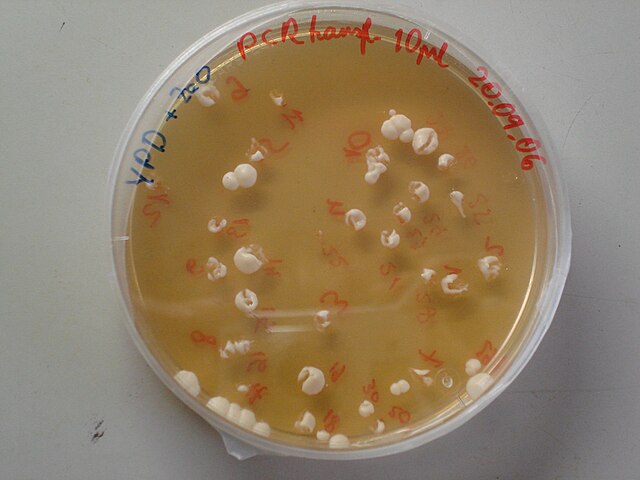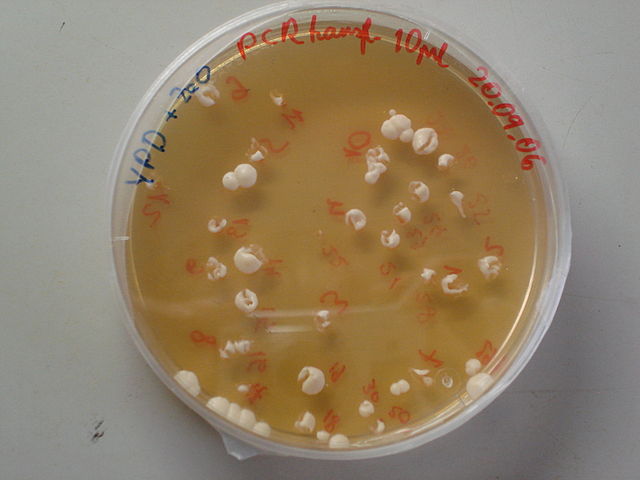This web page was produced as an assignment for an undergraduate course at Davidson College.
As yeast age, certain proteins may cause the association between mrna and protein levels to weaken.

Benjamin Franklin once said, “in this world, nothing is certain except death and taxes.” While yeast don’t have to pay taxes, unfortunately, they cannot live forever. In fact, yeast lifespans are influenced by hundreds of interconnected genes (Qin 2019). Alterations in expression levels of certain genes has been shown to affect the number of daughter cells a yeast cell can produce before it dies (Defossez et al. 1999). Since many of the genes that affect aging in yeast also appear to have similar effects in other organisms, including humans, understanding the mechanisms for cellular aging in yeast could have much broader significance (Janssens and Veenhoff 2016).
Under normal circumstances, genes produce mRNA transcripts which produce proteins, many of which are essential for the functioning of a yeast cell. As yeast age, the correlation between the level of mRNA transcripts produced by these genes and the level of essential proteins weakens (Yu et al. 2008). Yeast that continue to accurately and efficiently produce the proteins encoded by their genes tend to live longer; increased noise in transcription of genes and translation into proteins could ultimately lead to a chain of events eventually resulting in the death of the yeast (Kirkwood and Kowald 1997).
Since cellular functions are dependent on the interactions between proteins, any aging related breakdowns in these interactions could identify key factors in the relationship between yeast genes and their displayed phenotype. Guo et al. aimed to quantify the interactions between proteins by looking at the presence of mRNA transcripts and proteins over the course of a yeast’s lifetime. By using this data, they hoped to investigate the effects of the uncoupling of transcript and protein expression on protein interactions.
After identifying “essential genes” that produced proteins the yeast could not live without, Guo et al. observed opposite strikingly opposite trends in the expected protein interactions based on protein levels and mRNA transcript levels for essential protein interactions, especially at old ages. The predicted interaction landscape based on protein levels suggested higher probabilities of essential protein interactions in old age, while the interaction landscape based on transcript levels suggested lower probabilities.
By accounting for the relative rates of degradation of proteins, Guo et al. concluded that aging has a much greater impact on the protein interactions predicted by mRNA transcript levels. However, based on protein levels, fluctuations in expected protein interactions were found, consistent with the decoupling of protein and mRNA levels associated with aging. Overall, there were large fluctuations resulting from the essential genes and their interactions with the proteins that were not frequently degraded. On the other hand, the interactions between essential genes and quickly degraded proteins are relatively stable during aging, according to the predictions based on protein abundance, but not those based on the mRNA expression levels.
Although essential proteins were expected to have more interactions with other proteins, Guo et al. found them to be a distinct group from proteins with the most interactions. Despite being correlated, each group is likely to play different roles in aging. Importantly, essential genes that also encoded for proteins with lots of interactions tended to have increased protein abundances in aging yeast cells, while levels of essential proteins with few interactions actually decreased. On the other hand, mRNA transcript abundances decreased sharply with age for proteins with lots of interactions. This divergence can explain the disconnect in the interaction landscapes predicted from mRNA transcript and protein levels.
Genes that produce essential proteins with a high number of interactions with other proteins play a critical role in aging in yeast. These same genes face a large divergence in levels of mRNA transcript and protein abundance as cells age, information that can be used to identify potential causes of cellular aging in an organism with potential clinical significance to humans. Further research to better understand the subject is definitely needed. One possible flaw in Guo et al.’s study is that they assumed the decay rate for all interactions between proteins to be constant, while in reality this could be affected by a number of different factors. This dissociation constant significantly impacts interactions between essential proteins, due to the frequency of their interactions. Additionally, research in treatments that target highly interacting genes essential for cell function identified by this study could one day could delay the inevitable and extend cellular lifetimes.
Stephen Skrynecki is a Sophomore Biology and Economics Double Major at Davidson College. Contact him at stskrynecki@davidson.edu.
Resources
Defossez, P. A., Prusty, R., Kaeberlein, M., Lin, S. J., Ferrigno, P., et al. (1999). Elimination of replication block protein Fob1 extends the life span of yeast mother cells. Molecular cell, 3(4), 447–455.
Guo, H. B., Ghafari, M., Dang, W., & Qin, H. (2021). Protein interaction potential landscapes for yeast replicative aging. Scientific reports, 11(1), 7143.
Janssens, G. E., & Veenhoff, L. M. (2016). Evidence for the hallmarks of human aging in replicatively aging yeast. Microbial cell (Graz, Austria), 3(7), 263–274.
Kirkwood, T. B., & Kowald, A. (1997). Network theory of aging. Experimental gerontology, 32(4-5), 395–399.
Qin H. (2019). Estimating network changes from lifespan measurements using a parsimonious gene network model of cellular aging. BMC bioinformatics, 20(1), 599.
Yu, H., Braun, P., Yildirim, M. A., Lemmens, I., Venkatesan, K., Sahalie, et al. (2008). High-quality binary protein interaction map of the yeast interactome network. Science (New York, N.Y.), 322(5898), 104–110.
© Copyright 2021 Department of Biology, Davidson College, Davidson, NC 28036
